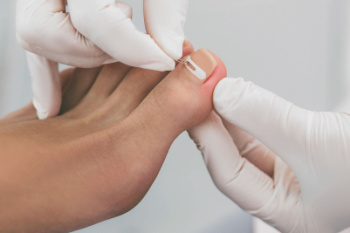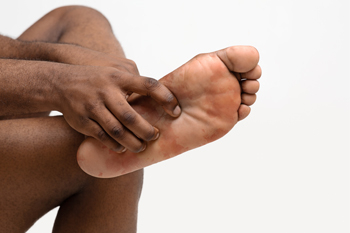Items filtered by date: December 2023
Chronic Ingrown Toenails

Chronic ingrown toenails can be a persistent and painful foot condition. They occur when the edge of the toenail, usually on the big toe, grows into the surrounding skin, leading to discomfort, swelling, redness, and sometimes infection. While an occasional ingrown toenail is common and often manageable at home, chronic ingrown toenails are a recurring problem. Several factors can contribute to chronic ingrown toenails, including improper nail trimming, wearing tight or ill-fitting shoes, genetics, and underlying foot deformities. Over time, chronic ingrown toenails can lead to pain and discomfort, making it difficult to walk and wear shoes comfortably. Treatment options for chronic ingrown toenails may include gently lifting the ingrown edge of the nail and placing cotton or dental floss under the nail to encourage it to grow away from the skin. In more severe cases, a podiatrist may need to trim or remove the ingrown portion of the nail, and in some instances, surgery may be necessary to permanently correct the problem. If you have ingrown toenails and you are experiencing pain or if it is a repeated issue, it is suggested that you schedule an appointment with a podiatrist for treatment and proper management of this condition.
Ingrown toenails can become painful if they are not treated properly. For more information about ingrown toenails, contact Dr. Mark Gagnon of Advanced Podiatry. Our doctor can provide the care you need to keep you pain-free and on your feet.
Ingrown Toenails
Ingrown toenails occur when a toenail grows sideways into the bed of the nail, causing pain, swelling, and possibly infection.
Causes
- Bacterial infections
- Improper nail cutting such as cutting it too short or not straight across
- Trauma to the toe, such as stubbing, which causes the nail to grow back irregularly
- Ill-fitting shoes that bunch the toes too close together
- Genetic predisposition
Prevention
Because ingrown toenails are not something found outside of shoe-wearing cultures, going barefoot as often as possible will decrease the likeliness of developing ingrown toenails. Wearing proper fitting shoes and using proper cutting techniques will also help decrease your risk of developing ingrown toenails.
Treatment
Ingrown toenails are a very treatable foot condition. In minor cases, soaking the affected area in salt or antibacterial soaps will not only help with the ingrown nail itself, but also help prevent any infections from occurring. In more severe cases, surgery is an option. In either case, speaking to your podiatrist about this condition will help you get a better understanding of specific treatment options that are right for you.
If you have any questions please feel free to contact one of our offices located in Crestwood, Orland Park, and Summit, IL . We offer the newest diagnostic and treatment technologies for all your foot and ankle needs.
Safeguarding Your Feet Throughout the Workday

In the hustle and bustle of the workday, it is easy to overlook the importance of foot health. Neglecting your feet can lead to discomfort and long-term issues. Begin by selecting proper footwear that provides ample support and a comfortable fit. Ensure your shoes are appropriate for your specific work environment, offering protection against potential hazards. Take breaks to stretch and move, promoting healthy blood circulation and preventing stiffness. Elevating your feet during breaks can also alleviate pressure. Maintain a clean and organized workspace to minimize the risk of tripping or falling. For employees who use ladders, it is beneficial to ensure the ladder stands securely on the ground. If your job involves prolonged periods of standing or walking, invest in anti-fatigue mats to cushion your feet. Regularly inspect your feet for any signs of discomfort, blisters, or swelling. Addressing issues promptly can prevent more serious complications. If you would like additional information about foot protection during the work day, it is suggested that you confer with a podiatrist.
While working on the feet, it is important to take the proper care of them. For more information about working on your feet, contact Dr. Mark Gagnon from Advanced Podiatry. Our doctor will treat your foot and ankle needs.
Working on Your Feet
Standing on your feet for long periods of time can cause stress and pain in your feet. Your whole body may experience change in terms of posture, back pain, bunions, callouses and or plantar warts. There are ways to avoid these conditions with proper foot care, smart choices and correct posture.
Positive Changes
Negative heeled shoe – Choosing this shoe type places the heel slightly lower than the ball of the foot. These are great for overall foot health. Find shoes that fit you correctly.
Go barefoot – Our feet were not designed to be enclosed for all hours of the day. Try to periodically expose your feet to air.
Eliminate Pain
Foot Exercises – Performing simple exercises, incorporating yoga and doing stretches are beneficial. This will allow increased blood flow to the area and muscles of the foot.
Achilles tendon – Stretching the foot out flat on the floor will relax the calf muscles and tendon. These exercises can be performed almost anywhere. Make sure you add these exercises to your daily regimen.
With a little bit of this information and knowing more about foot health, you will notice changes. Foot stretches and proper footwear will help with pain and prevent further issues.
If you have any questions please feel free to contact one of our offices located in Crestwood, Orland Park, and Summit, IL . We offer the newest diagnostic and treatment technologies for all your foot and ankle needs.
What is Plantar Fasciosis?

Pain on the bottom of the foot, particularly in the heel area, may be caused by plantar fasciosis, a condition often mistaken for plantar fasciitis. Unlike the latter, plantar fasciosis is characterized by repetitive stress on the plantar fascia rather than inflammation. Plantar fasciosis can develop due to a sedentary lifestyle, wearing high-heeled shoes, or having abnormal foot arches. Tight calf muscles or Achilles tendons also may contribute, and for that reason plantar fasciosis is common among runners, dancers, and anyone with poor foot posture. A sudden increase in activity or a shift to wearing less supportive footwear such as sandals, are other causes. The main symptom of plantar fasciosis is intense heel pain, particularly when first bearing weight in the morning or after periods of rest. A proper diagnosis involves a thorough examination of the foot and may include imaging tests. Understanding the difference between plantar fasciosis and plantar fasciitis is key to effective management of this type of pain. If you are grappling with persistent heel pain, it is suggested that you schedule an appointment with a podiatrist for a diagnosis and the appropriate treatment options.
Many people suffer from bouts of heel pain. For more information, contact Dr. Mark Gagnon of Advanced Podiatry. Our doctor can provide the care you need to keep you pain-free and on your feet.
Causes of Heel Pain
Heel pain is often associated with plantar fasciitis. The plantar fascia is a band of tissues that extends along the bottom of the foot. A rip or tear in this ligament can cause inflammation of the tissue.
Achilles tendonitis is another cause of heel pain. Inflammation of the Achilles tendon will cause pain from fractures and muscle tearing. Lack of flexibility is also another symptom.
Heel spurs are another cause of pain. When the tissues of the plantar fascia undergo a great deal of stress, it can lead to ligament separation from the heel bone, causing heel spurs.
Why Might Heel Pain Occur?
- Wearing ill-fitting shoes
- Wearing non-supportive shoes
- Weight change
- Excessive running
Treatments
Heel pain should be treated as soon as possible for immediate results. Keeping your feet in a stress-free environment will help. If you suffer from Achilles tendonitis or plantar fasciitis, applying ice will reduce the swelling. Stretching before an exercise like running will help the muscles. Using all these tips will help make heel pain a condition of the past.
If you have any questions please contact one of our offices located in Crestwood, Orland Park, and Summit, IL . We offer the newest diagnostic and treatment technologies for all your foot and ankle needs.
Keep Your Feet Healthy When Walking

Walking is a popular low-impact exercise with numerous health benefits, and ensuring your feet stay happy and healthy is key to maximizing those benefits. Proper form and posture when walking are essential elements to consider to prevent injuries. Maintaining proper posture and alignment is the foundation of a healthy walking routine. Imagine a string pulling you up from the crown of your head, ensuring you stand tall. Keep your head up, eyes forward, and shoulders back, allowing your arms to move freely at your sides. Tighten your abs and align your rib cage with your hips, knees, ankles, and second toe to avoid strain on your lower half. Pay close attention to your feet during each step. Adopt a rolling motion of heel, ball, and toes to distribute stress evenly across the lower body. Avoid slamming your entire foot down, as this can increase the risk of knee, hip, and ankle injuries. Notice your walking cadence and try to find a balance between longer, less frequent steps and shorter, more frequent steps to reduce joint stress. While walking is generally low-risk, staying alert is essential. Watch out for obstacles like curbs, potholes, or uneven terrain, especially in low-light conditions. If you have foot problems that you believe may be an after effect of your walking routine, it is suggested that you schedule an appointment with a podiatrist.
Exercising your feet regularly with the proper foot wear is a great way to prevent injuries and build strength. If you have any concerns about your feet, contact Dr. Mark Gagnon from Advanced Podiatry. Our doctor can provide the care you need to keep you pain-free and on your feet.
Exercise for Your Feet
Exercise for your feet can help you gain strength, mobility and flexibility in your feet. They say that strengthening your feet can be just as rewarding as strengthening another part of the body. Your feet are very important, and we often forget about them in our daily tasks. But it is because of our feet that are we able to get going and do what we need to. For those of us fortunate enough to not have any foot problems, it is an important gesture to take care of them to ensure good health in the long run.
Some foot health exercises can include ankle pumps, tip-toeing, toe rises, lifting off the floor doing reps and sets, and flexing the toes. It is best to speak with Our doctor to determine an appropriate regimen for your needs. Everyone’s needs and bodies are different, and the activities required to maintain strength in the feet vary from individual to individual.
Once you get into a routine of doing regular exercise, you may notice a difference in your feet and how strong they may become.
If you have any questions please feel free to contact one of our offices located in Crestwood, Orland Park, and Summit, IL . We offer the newest diagnostic and treatment technologies for all your foot and ankle needs.

